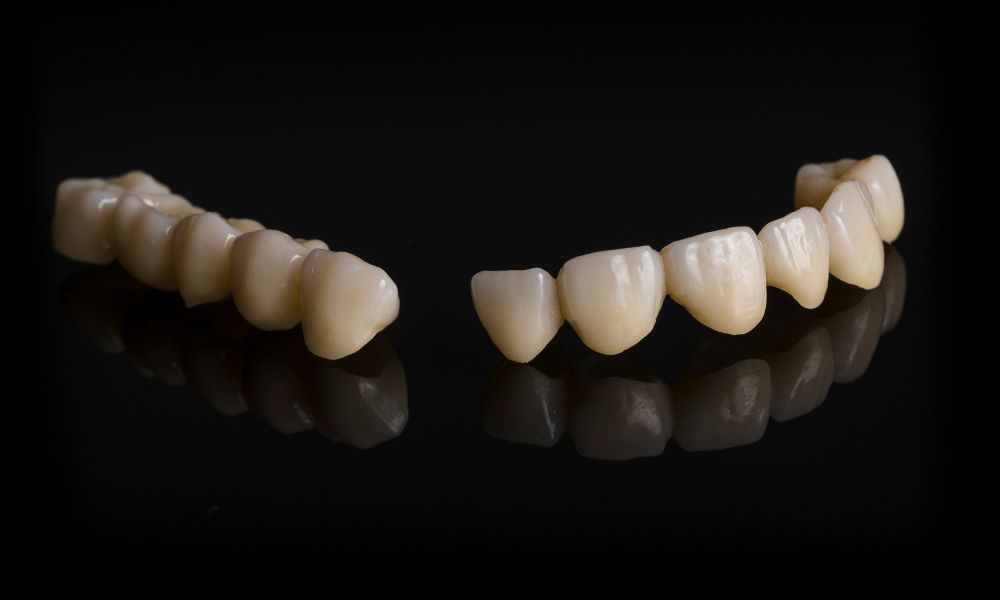December 28, 2022


Written by:
Dylan Schubert
Zirconia is an excellent choice for long-lasting and realistic dental restorations, but the decision-making doesn’t stop there. Different types of zirconia crowns require you to think even further about the best restoration options. Does your patient’s case require you to prioritize esthetics? Or does your patient need a restoration that emphasizes strength above all else?
These questions can help you determine whether a monolithic or layered zirconia crown is the better choice, but there is not always a clear answer. However, understanding the pros and cons of each type of restoration will help you make the best possible choice for your patient.
Zirconia, also known as zirconium dioxide, is a popular material used for dental restorations. First introduced around 2010, zirconia serves as a better alternative for porcelain-fused-to-metal (PFM) crowns as it is metal-free and biocompatible. Zirconia is highly versatile and can take different forms, which leads to some debate when determining the best option to use for a given restoration. There are two main types of zirconia crowns: monolithic and layered.
Monolithic zirconia crowns, also known as solid zirconia, are made from a single, unbroken block of zirconia. Monolithic zirconia restorations may also be referred to as full-contour zirconia. Solid zirconia restorations are designed and milled from pieces of solid zirconia using advanced milling machines.
These restorations are best known for their sheer strength and durability and have no porcelain overlay. The lack of overlay means that these restorations are easier to set with less space between teeth.
Layered zirconia crowns are restorations that are layered with different ceramic powers that mimic the translucency of the natural surrounding dentition. This material is also sometimes known as multilayer zirconia or porcelain layered zirconia. Layered zirconia maintains most of the strength of monolithic zirconia with advanced esthetics.
The ceramic layer helps to provide a more natural appearance to the restoration, which gives patients more confidence in their smiles. Layered zirconia achieves these solid esthetics by adding fluorescence and opalescence to the restoration, allowing the crown to better blend in with the surrounding teeth.
Although both monolithic zirconia and layered zirconia have their benefits, your choice will depend most on a patient’s specific case. In order to decide which is the best option for your patient, you should weigh the pros and cons of each material in four key areas.
With a zirconia foundation, both monolithic and multilayered zirconia feature impressive strength and durability. Patients will enjoy peace of mind while chewing and biting with either option, as monolithic zirconia features a flexural strength of 1000 MPa, and layered zirconia has a slightly lower flexural strength of around 900-1000 MPa.
The solid block of zirconia used to create monolithic zirconia restorations makes it almost impossible to chip or crack. Layered zirconia features similar strength since it is constructed with a zirconia foundation, but the porcelain layer does present a higher risk for fractures or cracking on the coating of the restoration.
Since zirconia only became a popular option around 13 years ago, there is limited research on the long-term durability of the material. However, according to the studies that are available so far, monolithic zirconia has an admirable survival rate of 98% over five years. Even with more research still to be done, experts believe that zirconia can last twenty years or more with proper care.
When accounting for durability and longevity, it is important to note, too, that monolithic zirconia leads to the least wear on your opposing teeth when compared to layered zirconia. The polishing process can have a significant impact, though, as polished zirconia led to less wear on opposing teeth than unpolished zirconia.
Both monolithic and layered zirconia feature an impressive natural look, but layered zirconia maintains the benefit of being the more esthetic option between the two. The ceramic powders of layered zirconia provide more translucency and opalescence. The fluorescence allows a tooth to appear more natural and realistic while blending in better with your natural teeth.
Meanwhile, monolithic zirconia is more opaque and does not blend in as well. It does not stand out significantly from your other teeth, but it is noticeable if you are paying attention. As a result, monolithic zirconia is generally the better option for posterior teeth, while porcelain layered zirconia is the better choice for anterior teeth. However, solid zirconia can be adapted to feature a more realistic appearance as well with the right manufacturing technique and polishing.
The manufacturing process looks slightly different for monolithic and layered zirconia crowns. The process can also vary depending on the laboratory and can influence the final traits of the restorations.
At PRO-Craft, we use very thoughtful processes to create uniquely high-quality zirconia crowns. Our monolithic zirconia crowns are created using the most advanced milling machines in the industry and feature no porcelain overlay. We craft our multi-layered crowns by using a block of zirconia and then hand-layering the porcelain layers for the ideal appearance. Then, to top it off, we use zirconia contact points for fracture resistance.
When designing both monolithic and layered zirconia restorations, we use our custom library to ensure natural tooth morphology so that every restoration feels and fits like a real tooth.
For both types of restorations, we also use a hand-pumicing and polishing technique to ensure a smooth surface. This smooth surface both resembles a natural tooth and protects your opposing teeth from excessive wear. Our proprietary tinting process also helps to provide a more natural, translucent appearance, even in solid zirconia.
The last main point to consider is how much clearance you have for a restoration. Solid zirconia requires less occlusal clearance making it a better option for patients with less space to work with or in cases where a significant tooth reduction is not practical.
For the best results, a zirconia crown needs a minimal marginal depth of 0.6mm and an axial wall reduction of at least 1.0mm, in addition to a 1.5mm occlusal reduction. The clearance needed for a layered zirconia restoration is slightly larger.
On the bright side, both types of zirconia need little preparation for the restorations themselves, especially when they are created and polished using a detailed manufacturing process.
Ultimately, both layered zirconia and monolithic zirconia have their advantages, so it is impossible to say that one is definitively better. The better option will always depend on the application and your patient’s specific needs.
For example, if you have a patient with extreme bruxism, then the sheer strength of monolithic zirconia will be more appropriate for preventing fractures. Monolithic zirconia is also the better option when a patient has low occlusal clearance. However, if you have a patient with an anterior tooth in need of a restoration, then the esthetic benefits of layered zirconia are going to prevail.
There will also be situations where you could use either option for a positive result. In these cases, you should ask whether the priority is esthetics or strength to help you decide.
There are multiple benefits to using either layered zirconia or monolithic zirconia crowns, and they each have their appropriate applications. If you need assistance deciding between the two options, contact PRO-Craft Dental Laboratory. We are happy to provide more detail about the upsides of each option.
No matter which material you decide on, you can trust PRO-Craft Dental Laboratory to provide both quality monolithic and layered zirconia restorations. We provide special care and attention to every little detail for maximum patient satisfaction. We always go the extra mile in our process, using our signature hand-pumicing and hand-polishing process to ensure the natural appearance and function of the restoration. Explore our selection of crowns and bridges to see the quality for yourself.

Zirconia has revolutionized the dental industry with its versatility and robustness. It is renowned for its strength, making it a material of choice for dental restorations. Moreover, zirconia is...
Read More.png)
Zirconia crowns have quickly become one of the most popular materials for dental restorations. Both patients and providers appreciate zirconia crowns for their durability, strength, translucency and...
Read More
Proper tooth restorations should balance increasing the functionality and the appearance of a patient’s damaged or decayed tooth while lasting as long as possible. Two of the most common materials...
Read More